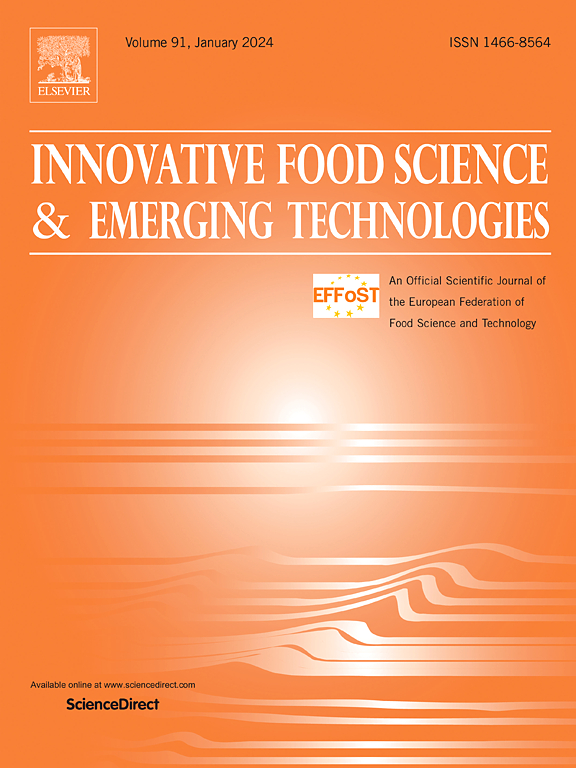Impact of blue-LED as a non-thermal preservation technology on bio-active compounds, quality parameters, microbial and enzymatic spoilage of guava juice
IF 6.8
1区 农林科学
Q1 FOOD SCIENCE & TECHNOLOGY
Innovative Food Science & Emerging Technologies
Pub Date : 2025-06-19
DOI:10.1016/j.ifset.2025.104092
引用次数: 0
Abstract
Even though pasteurization is commonly practiced and efficient in inhibiting the growth of microorganisms in fruit juices, there is a desire for non-thermal processes that retain the nutrients and sensory attributes of the juices. Therefore, this study aimed to produce healthy guava juice with high bioactive compounds using LED technology (T1: treated with blue wavelength 445 nm for 10 min and T2: treated with blue wavelength 445 nm for 30 min), compared to C: control (juice without treatment) and T3: pasteurized juice (at 90 °C for 60 s). All samples were evaluated during storage at 5 °C for 2 weeks. The results found that T2 was the superior processing method that maintained the juice's bioactive compounds, such as vitamin C, total phenol, and antioxidants, which reached 37.54 and 15.54 mg/100 mL; 30.46 and 17.89 mg/100 mL and 65.98 and 13.33 % in the T2 and C juice samples, respectively. In addition, LED treatments maintained sensory characteristics (taste, odor, and color) with no significant difference from the control sample, without an aftertaste at zero time, and extended the shelf life for over 14 days, as indicated by the microbial load, which did not exceed the acceptable limit (6 Log CFU/g). Additionally, the T3 recorded no microbial growth, enzymatic activity, and optimal preservation of vitamin C, compared to the control, which showed a gradual degradation of vitamin C. reaching 15.45 mg/100 mL (p < 0.05). Therefore, LED technology could be a promising non-thermal food preservation technique for producing high-quality, healthy products with a long shelf-life and low production costs.
蓝- led非保温技术对番石榴汁生物活性成分、品质参数、微生物及酶腐蚀的影响
尽管巴氏灭菌法在抑制果汁中微生物的生长方面很常用,而且很有效,但人们还是希望采用非加热的方法来保留果汁的营养和感官属性。因此,本研究旨在利用LED技术生产具有高生物活性化合物的健康番石榴汁(T1:用445 nm蓝色波长处理10分钟,T2:用445 nm蓝色波长处理30分钟),与C:对照(未经处理的果汁)和T3:巴氏杀菌果汁(90°C, 60秒)相比。所有样品在5°C保存2周期间进行评估。结果发现,T2处理方法能保持果汁中维生素C、总酚和抗氧化剂等生物活性成分的含量,分别达到37.54和15.54 mg/100 mL;T2和C果汁样品的含量分别为30.46和17.89 mg/100 mL, 65.98和13.33%。此外,LED处理保持了感官特征(味道、气味和颜色),与对照样品没有显著差异,零时间无余味,并延长了保质期超过14天,微生物负荷表明,没有超过可接受的限制(6 Log CFU/g)。此外,与对照组相比,T3没有微生物生长,酶活性和维生素C的最佳保存,维生素C的逐渐降解达到15.45 mg/100 mL (p <;0.05)。因此,LED技术可能是一种很有前途的非热食品保鲜技术,可以生产出高质量、健康、保质期长、生产成本低的产品。
本文章由计算机程序翻译,如有差异,请以英文原文为准。
求助全文
约1分钟内获得全文
求助全文
来源期刊
CiteScore
12.00
自引率
6.10%
发文量
259
审稿时长
25 days
期刊介绍:
Innovative Food Science and Emerging Technologies (IFSET) aims to provide the highest quality original contributions and few, mainly upon invitation, reviews on and highly innovative developments in food science and emerging food process technologies. The significance of the results either for the science community or for industrial R&D groups must be specified. Papers submitted must be of highest scientific quality and only those advancing current scientific knowledge and understanding or with technical relevance will be considered.

 求助内容:
求助内容: 应助结果提醒方式:
应助结果提醒方式:


